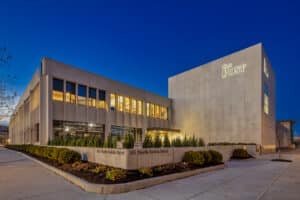Heavy timber construction is a traditional building style that uses large heavy sawn timbers for structural framing. This building style has been around for quite some time. In fact, some timber framed buildings in Europe were constructed over 500 years ago and are still standing today.
Until recently, the role of wood in commercial construction has largely been limited to heavy timber and light-frame construction types, both of which are restricted by national building codes to low and mid-rise heights. The International Building Code (IBC) placed strict height limitations on wood structure buildings largely because of wood’s combustibility.
Compared to steel and concrete, a wood-framed building can burn up to three times faster, making taller buildings unsafe in case of a fire. This limits the ability to use this material in many settings. As urban populations continue to grow in nearly every major city including Syracuse, the need for commercial high rises grows with it. How will wood compete with steel and concrete if building codes prevent it from doing so?
Glue laminated and cross-laminated timber (CLT) are large engineered framing structures comprised of several layers of wood planks, which are stacked and glued together. By angling these layers at 90 degrees to each other, the resulting finished product has bi-directional strength like plywood, but much thicker and stronger. Europe has been utilizing this building method since the early 20th century.
It wasn’t until the beginning of this decade that the U.S. wood industry started developing product standards and revamping building codes to jumpstart mass timber as a viable alternative to its industrial, more energy-intensive counterparts. The design and construction industry has caught on to mass timber’s potential, and there is now an International Code Council Ad Hoc Committee on Tall Wood Buildings that has been tasked with increasing the height and code area limits on commercial mass timber buildings.
Wondering what makes this new construction method so much better than steel and concrete? Or why is there so much third-party effort to alter building codes and advance mass timber construction? The answer is simple. These buildings are cheaper to build, have a lighter carbon footprint, and are preferred by occupants.
Learn more below.
Benefit 1: Economical
Costs associated with the construction of mass timber buildings are equivalent to traditional steel and concrete. However, mass timber construction takes less time to build compared to steel and concrete, which means lower labor and scheduling costs.
Some firms have claimed that from their experience, a mass timber project can be 25% faster to construct than a similar concrete project. For instance, the T3 building in Minneapolis, the country’s first modern mass timber structure at 220,000 square feet, was framed at around 30,000 square feet of floor space per week. The rapid building associated with mass timber projects can produce substantial financial benefits for building owners.
Another factor that adds fiscal benefits is related to material weight. Since mass timber products weigh significantly less than traditional structural materials, smaller foundations are required, which equates to less material used and cost savings.
Benefit 2: Sustainability
Perhaps one of the biggest reasons for the design industry’s push towards mass timber construction is the sustainability aspect associated with it. As Paul Hawken’s now-famous climate action book and website notes, “Building with wood could reduce annual global emissions of carbon dioxide by 14 to 31 percent.” That is a pretty staggering statistic. Building with mass timber products instead of concrete or steel enables these large emission reductions because of two major factors: (1) the sequestering of carbon and (2) the process of creating engineered wood.
As trees grow, they absorb and capture carbon, which remains stored in mass timber materials. One unit of dry wood is composed of 50% carbon and this carbon is “locked in” while the wood is being used in a building. Alongside this benefit, mass timber products produce fewer greenhouse gases during manufacturing compared to alternatives like cement and steel.
These environmental perks can improve public outlook and support of a large project, and help project teams easily achieve green building certifications such as LEED. Interested in learning more about sustainability? Check out these 5 examples of green building.
Benefit 3: Preferred by building occupants
As witnessed by many heavy timber apartments and offices, including VIP Structures’ One Webster’s Landing project, the visibility of structural wood and woodgrain patterns inside a building brings along health benefits. An increasing number of studies have shown that the use of natural materials, like wood, correlates to improvements in occupant health and well-being.
For office environments and apartment buildings, the desired look and comfort of mass timber enables higher rents and often equates to longer-term tenants, which is a great bonus to building owners. Schools are also eyeing this material for educational buildings because wood serves as a moisture buffer, helps to moderate interior humidity, and improves air quality. The University of British Columbia chose to use mass timber for one of their newest dormitories, which is also one of the largest mass timber buildings in the world.
In Summary
As one of the oldest and most trusted building materials, wood is making a comeback with commercial buildings thanks to technological advancements in manufacturing and engineering. A slew of advanced structural wood products, encompassed under the category of “mass timber,” are enabling designers to create high-rise buildings that are both fire-retardant and structurally competitive with steel and concrete.
VIP Structures is an integrated design-build firm in Upstate New York. Interested in learning more? Browse our design-build blog or visit our website.



